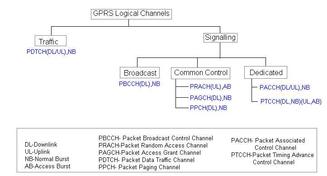GSM/GPRS Loopback Test Types Explained
Advertisement
This document describes GSM/GPRS loopback tests, specifically focusing on loopback types A, B, C, D, E, F, I, and G/H, which are used for performance testing of GSM/GPRS mobile phones.
Loopback A
-
Target: Residual measurements.
-
Process: The test equipment sends a message to the Mobile Station (MS) instructing it to close Loopback A. Layer 3 commands are sent on the DCCH (SDCCH/FACCH). On Layer 2, SAPI 0 is used in acknowledged mode. The MS erases frames received with CRC errors and replaces all the bits in those frames with zeros.
-
Type A Measurements:
- BER for data TCH
- Number of Bits Tested
- FER for speech TCH
- RBER for speech TCH
- EVSIDUR and EVRFR for AMR speech TCH
Loopback B
-
Target: Non-residual measurements.
-
Process: The test equipment sends a message to the MS instructing it to close Loopback B. The mobile station does not indicate if any frames in the downlink were erased. The Bit Error Rate (BER) measurement on the test equipment can then return a CRC count.
-
Type B Measurements:
- BER
- Bits Tested
- CRC Ratio
- CRC Count
Loopback C
-
Description: Burst-by-Burst Loopback.
-
Process: 114 information bits of each Downlink (DL) TCH burst (excluding Stealing Bits - SB) are transmitted in an Uplink (UL) burst after encryption but before applying the channel decoder.
-
Round Trip Delay (RTD): The number of frames between the reception of one burst at the MS and the transmission of the same burst in UL. The RTD is less than 26 frames.
-
Note: SACCH is not looped back.
Loopback D
- Description: Measurement of signalling of Erased frames and unreliable frames for TCH/HS channel.
- Process:
- If a reliable speech frame (UFI=0) is correctly received by the MS in DL, then the output of the Channel Decoder (CHD) is input to the Channel Encoder (CHE) and transmitted in UL.
- If a bad speech frame (BFI=0) or unreliable speech frame (UFI=1) is received in DL, or FACCH is detected, the input frame to CHE is all zeros and transmitted on UL.
- FACCH processing is performed normally.
- Note: SACCH is not looped back.
Loopback E
- Description: Used for TCH/HS channel and measures signalling of erased SID Frames.
- Process:
- If a valid SID frame (SID=2) or invalid SID frame (SID=1) are received by the MS in DL, then the output of the Channel Decoder (CHD) is input to the Channel Encoder (CHE) and transmitted in UL.
- If the CHD detects an erased SID frame (SID=0) or FACCH is detected, the input frame to CHE is all zeros and transmitted in UL.
- FACCH processing is performed normally.
Loopback F
- Description: TCH/HS: Signalling of erased valid SID Frames.
- Process:
- If a valid SID frame (SID=2 and BFI=0) is received by the MS in DL, then the output of the Channel Decoder (CHD) is input to the Channel Encoder (CHE) and transmitted in UL.
- If the CHD detects an erased valid SID frame (SID=1, or SID=0, or BFI/UFI=1), or if FACCH is detected, the input frame to CHE is all zeros and transmitted in UL.
- FACCH processing is performed normally.
Loopback I
- Description: This test is used for AMR Speech Channel measurement.
- Condition: Loop I is only required to operate when DL DTX is NOT used.
- Exceptions: When SID_FIRST/SID_FIRST_P1/SID_FIRST_P2/SID_FIRST_INH/SID_UPDATE/ SID_UPDATE_INH/ONSET is detected, there is no need for in-band signalling loopback.
- Limitations: Loop I is not designed to measure the performance of in-band signalling over SID_UPDATE or RATSCCH messages.
Loopback G/H
-
Description: Used for multi-slot TCH loop measurements.
-
Loopback G:
- The 114 information bits of each multi-slot TCH burst (excluding stealing flags) prior to applying the benefit of the channel decoder, but after decryption, shall be transmitted in an uplink burst.
- All that is received shall be re-transmitted.
- SACCH and idle bursts are not looped back.
-
Loopback H:
- Includes the signalling of erased frames and is used to determine Frame Erasure Ratio (FER), Residual Bit Error Ratio (RBER), and Bit Error Ratio (BER) for any multi-slot configuration TCH.
Advertisement
 RF
RF
